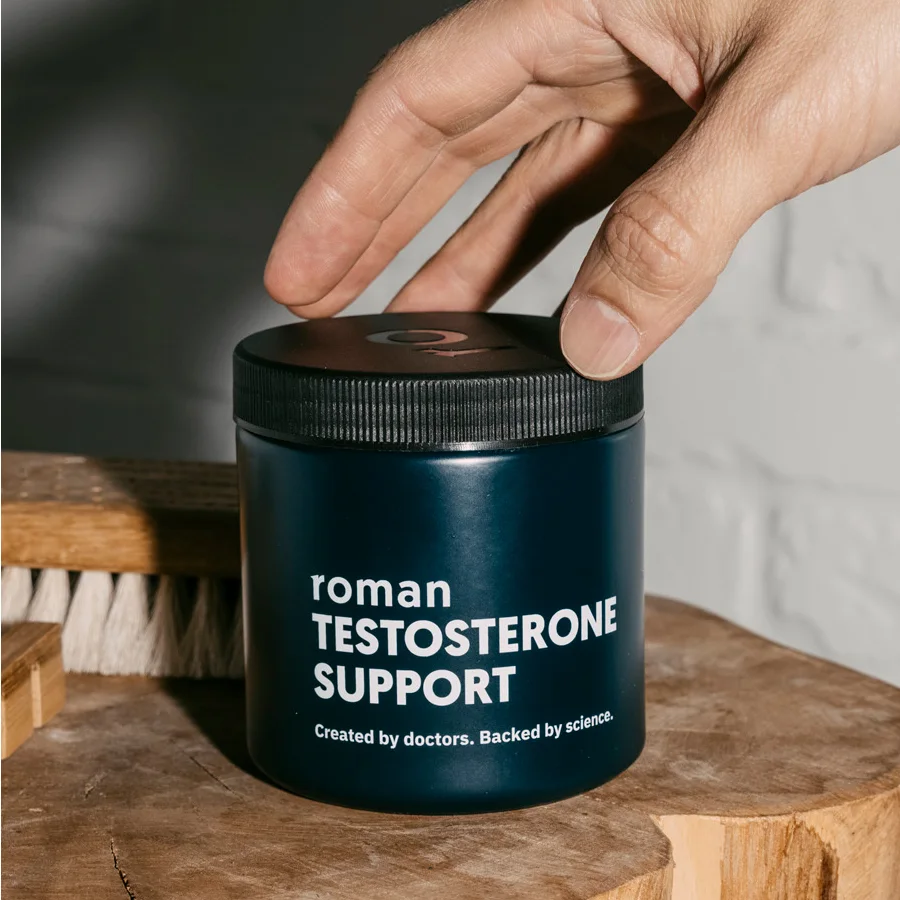Here's what we'll cover
Here's what we'll cover
Here's what we'll cover
An onslaught of commercials and online ads promising to cure low testosterone (also referred to as low T) might have you wondering–do I have low testosterone?
Low testosterone causes distinct symptoms like low sex drive, weight gain, breast tenderness and more. Low T is diagnosed with two blood tests (testosterone levels change throughout the day, so two tests that fall below the “normal” range are required for a diagnosis). If you’re diagnosed with low T, you have options for treatment. One of those options is a testosterone patch for testosterone replacement therapy (TRT). Not everyone is a candidate for TRT. Continue reading to learn more about the testosterone patch.
What are testosterone patches?
The testosterone patch is an FDA-approved prescription treatment for low testosterone (also known as hypogonadism). It's one method of testosterone replacement therapy. The patch is transdermal, meaning it's applied to the skin where it releases a slow, continuous dose of hormones into the bloodstream.
The testosterone patch is sold under the brand name AndroDerm. It’s not available over-the-counter or as a generic medication. Clinical trials show that 97% of men with low T who tried the patch achieved a normal testosterone level.
Other data indicates that AndroDerm is one of the most effective TRT products, with up to 92% of people reaching normal testosterone levels.
Testosterone patches should be applied once a day to clean, dry, and intact skin. Common spots to place it include the back, abdomen, upper body, or thighs. You should not apply it to the scrotum. Make sure to change your application site to avoid skin irritation.
Risks and side effects of the testosterone patch
Like many prescription drugs, TRT comes with certain risks––some mild, some severe. Potential side effects of TRT include:
Infertility and shrinking of the testicles
Gynecomastia (enlarged male breasts)
Calcification of blood vessels
Blood clots
Changes in urine flow, including difficulty with urination
Sleep apnea
Swelling in the legs or ankles
Erythrocytosis (production of too many red blood cells)
Other possible side effects of transdermal testosterone include redness, irritation, rash, or blisters at the application site.
Testosterone replacement therapy isn't for everyone. It may not be right for you if you have certain medical conditions, such as breast or prostate cancer, a prostate nodule, or an elevated PSA level.
TRT potentially heightens the risk of developing prostate cancer or an enlarged prostate (benign prostatic hyperplasia). The thought behind this is testosterone can drive prostate growth and increase what are called prostate-specific antigen (PSA) levels. Large-scale clinical trials haven’t been conducted on TRT and the risk of cancer or BPH, so more research is needed.
Although research is varied, TRT may increase risk of cardiovascular problems, including heart attack or stroke. TRT also suppresses your body’s natural ability to make testosterone, which can affect your fertility.
This is not a complete list of risks and potential side effects of TRT. Seek medical advice from a healthcare professional or ask your pharmacist if you have questions about the potential risks and side effects of the testosterone patch.
How can I get the testosterone patch?
The testosterone patch is available by prescription only. Talk with a healthcare provider if you suspect you might have low T and see if the testosterone patch is right for you.
What is testosterone?
Testosterone is an androgen, or primary biological male sex hormone, which is present from birth in all people. In biological men, it’s produced by the testicles and adrenal glands, while in biological women, it’s produced by the ovaries and adrenal glands.
During puberty, testosterone levels surge, prompting muscle growth, body hair growth, voice deepening, and the development of sperm. Testosterone plays an important role in our health throughout life. It regulates key functions like libido, sexual response, bone density, muscle mass, and mood. Testosterone levels naturally decline with age.
What are normal testosterone levels in men?
Your testosterone level is measured with two blood tests or a test kit involving a saliva sample. According to the American Urological Association (AUA), a total testosterone value below 300 ng/dL indicates low testosterone in biological men. However, the exact range of normal values varies, depending on the lab or resource that conducts the test.
How common is low testosterone?
Low testosterone (or testosterone deficiency) tends to appear in men as they get older, with testosterone levels decreasing about 1–2% per year after age 40. By the time they hit their 70s, around 35% of men have low testosterone.
Symptoms of low testosterone
The symptoms of low testosterone can include:
Erectile dysfunction (with loss of morning erections)
Fatigue
Loss of muscle mass
Increased body fat
Anemia
Loss of bone mass (osteoporosis)
Depressed mood
Fertility issues (like low sperm count)
Other treatments for low testosterone
There are several other options available to treat low T.
Topical treatments
Besides the testosterone patch, other forms of TRT you can apply to the skin include testosterone gels (brand names AndroGel, Testim, and Fortesta) and solutions (brand name Axiron). The benefit of topical treatments is that they're absorbed slowly, making levels in the blood very stable.
Injections
There are many different injectable forms of testosterone available. Some are self-administered at home, while others are administered by a healthcare provider. Depending on the injectable, they can last anywhere from a week to a few months.
Buccal (cheek)
The buccal testosterone system (brand name Striant) is a medication designed to stick to your gums. The main disadvantage of Striant is that it can cause irritation.
Pellets
Testosterone pellets (brand name Testopel) are implanted in the hip (just under the skin). Over 3–6 months, they slowly release testosterone into the body.
Nasal gel
Nasal testosterone gel (brand name Natesto) is applied to each nostril three times a day. Many healthcare providers are waiting for long-term safety data before prescribing it.
Healthcare providers often recommend trying topical gel forms of testosterone first because they provide stable testosterone levels and are relatively easy to use. But studies don’t show much difference in user satisfaction between TRT gels, injections, or pellets.
If you suspect you may have low testosterone levels, make an appointment with your healthcare provider. They’ll assess if you have low testosterone and develop a treatment plan that’s right for you.
DISCLAIMER
If you have any medical questions or concerns, please talk to your healthcare provider. The articles on Health Guide are underpinned by peer-reviewed research and information drawn from medical societies and governmental agencies. However, they are not a substitute for professional medical advice, diagnosis, or treatment.
References
DailyMed. (2020). Androderm–testosterone patch. Retrieved on Feb. 21, 2023 from https://dailymed.nlm.nih.gov/dailymed/drugInfo.cfm?setid=e58a5328-fdd9-40cb-a19f-8ed798989b9c
Fernández-Balsells, M. M., Murad, M. H., Lane, M., et al. (2010). Adverse effects of testosterone therapy in adult men: a systematic review and meta-analysis. The Journal of Clinical Endocrinology & Metabolism , 95 (6), 2560–2575. doi:10.1210/jc.2009-2575. Retrieved from https://www.ncbi.nlm.nih.gov/pubmed/20525906
Grech, A., Breck, J., & Heidelbaugh, J. (2014). Adverse effects of testosterone replacement therapy: an update on the evidence and controversy. Therapeutic Advances in Drug Safety , 5 (5), 190–200. doi:10.1177/2042098614548680. Retrieved from https://www.ncbi.nlm.nih.gov/pmc/articles/PMC4212439/
Harman, S. M., Metter, E. J., Tobin, J. D., et al. (2001). Longitudinal effects of aging on serum total and free testosterone levels in healthy men. The Journal of Clinical Endocrinology & Metabolism , 86 (2), 724–731. doi:10.1210/jcem.86.2.7219. Retrieved from https://www.ncbi.nlm.nih.gov/pubmed/11158037
Kovac, J. R., Rajanahally, S., Smith, R. P., et al. (2014). Patient satisfaction with testosterone replacement therapies: the reasons behind the choices. The Journal of Sexual Medicine , 11 (2), 553–562. doi:10.1111/jsm.12369. Retrieved from https://www.ncbi.nlm.nih.gov/pubmed/24344902
Luthy, K. E., Williams, C., Freeborn, D. S., et al. (2017). Comparison of testosterone replacement therapy medications in the treatment of hypogonadism. The Journal for Nurse Practitioners , 13 (4), 241-249. doi:10.1016/j.nurpra.2016.11.016. Retrieved from https://www.npjournal.org/article/S1555-4155(16)30716-4/pdf
Miah, S., Tharakan, T., Gallagher, K. A., et al. (2019). The effects of testosterone replacement therapy on the prostate: a clinical perspective. F1000Research , 8. doi:10.12688/f1000research.16497.1. Retrieved from https://www.ncbi.nlm.nih.gov/pmc/articles/PMC6392157/
Mulhall, J. P., Trost, L. W., Brannigan, R. E., et al. (2018) Evaluation and management of testosterone deficiency: AUA guideline. Journal of Urology, 200,
Retrieved from https://pubmed.ncbi.nlm.nih.gov/29601923/
Petering, R. C. & Brooks, N. A. (2017). Testosterone therapy: review of clinical applications. American Family Physician , 96 (7), 441–449. Retrieved from https://pubmed.ncbi.nlm.nih.gov/29094914/
Sizar, O. & Schwartz, J. (2022). Hypogonadism. Retrieved on Feb. 21, 2023 from https://www.ncbi.nlm.nih.gov/books/NBK532933/










